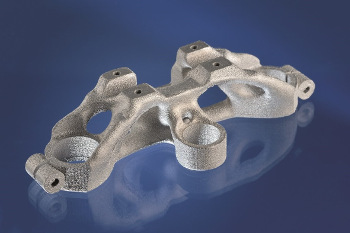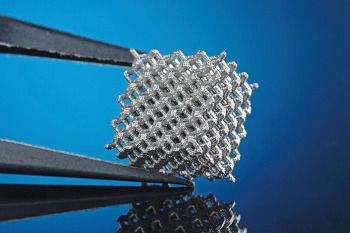 |
| March 08, 2016 | Volume 12 Issue 10 |
Designfax weekly eMagazine
Archives
Partners
Manufacturing Center
Product Spotlight
Modern Applications News
Metalworking Ideas For
Today's Job Shops
Tooling and Production
Strategies for large
metalworking plants
Wheels:
Stronger, lighter parts -- new technique uses selective laser melting on magnesium alloys

Demonstrator for a topology-optimized motorcycle triple clamp using a SLM-formed magnesium alloy (material: AZ91). [®Photo Fraunhofer ILT, Aachen, Germany/Volker Lannert]
A special processing technique developed by researchers in Germany allows selective laser melting (SLM) to be used with more difficult materials such as magnesium alloys, copper alloys, and other crack-prone, difficult-to-weld metals.
The use of these materials makes it possible to employ the SLM process, an additive manufacturing (metal 3D-printing) technique, in new application areas using new materials, such as lightweight car parts and medical devices. Magnesium, for example, is 30 percent lighter than aluminum. Alloys of this material can be even lighter.
Selective laser melting with "normal" materials such as stainless steel, aluminum, or titanium alloys has already come of age in the world of production. The materials and processes have been extensively researched, and the related machinery to produce parts is available from a number of vendors. These machines use powdered metals that are melted layer by layer to form the final design.
Things get challenging when attempting to work with other materials such as magnesium, which have proven difficult for a number of reasons, including the aforementioned cracking; the material's low boiling point, low evaporation heat, and low viscosity compared to established materials using the process; and not producing smooth surfaces or defined edges.
Experts at Fraunhofer ILT have developed a processing technique that makes it possible to work these difficult materials using SLM. And to combat heavy smoke formation, a new process chamber featuring optimized shielding gas flow was developed in cooperation with ILT spinoff Aconity3D for use with magnesium alloys. In addition, processes for use with copper alloys were optimized, as were special systems with high-temperature preheating for use with crack-prone and difficult-to-weld metals.
This opens the door to new applications not only in lightweight construction, but also in medical technology, such as custom-made surgical bone replacements.
Lighter and stronger auto and aero parts: SLM allows for full topology optimization
The advantages of magnesium alloys have been known in the worlds of aerospace and motorsports for a long time. These materials are much lighter than aluminum, yet they are also much more difficult to work with.
The new SLM processing technique solves this problem in an elegant fashion. To explore the concept in detail, Fraunhofer ILT constructed a motorcycle triple clamp in 1:4 scale by optimizing the entire topology of the component by computer. The objective was to achieve full structural and weight optimization for comparable lightweight parts.
The researchers say that their efforts represent one of the world's first examples of complex components made from magnesium alloys. In terms of quality, they are equal to other SLM products, yet with respect to strength they are even superior to cast parts.
On the medical side
Desirable features of medical implants, such as tailored designs and complex structures, can be produced at no extra expense using SLM. As a material, magnesium offers the added advantage of being resorbable by the human body. Implants based on solid magnesium materials are already in use, but further benefits are promised for implants that feature pore structures.

Implant (scaffold) with defined pore structure made from biodegradable magnesium alloy (WE43). [®Photo Fraunhofer ILT, Aachen, Germany/Volker Lannert]
The idea here is that new bony material will grow into the implant, while at the same time the metallic material is resorbed by the body. Fraunhofer ILT has developed an SLM process for magnesium alloy implants of this type, in which both the exact shape and pore size of the implant can be chosen. The biocompatibility of the implant prototypes has already been demonstrated in vitro.
While Fraunhofer ILT continues to research new materials and processes, SLM equipment for magnesium alloys is available from Aconity3D, which is a Fraunhofer start-up company.
In addition to magnesium alloys, research work is continuing on developing SLM for processing novel materials such as high-temperature alloys for turbomachinery applications or copper alloys. The various processes will be exhibited at the International Laser Technology Congress AKL'16 in Aachen, Germany, April 27-29, 2016.
Source: Fraunhofer ILT
Published March 2016
Rate this article
View our terms of use and privacy policy
